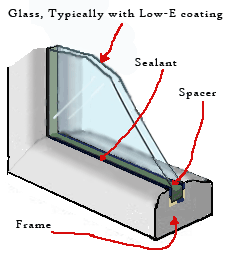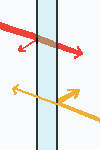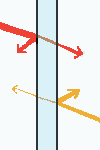Windows
Windows provide light, ventilation and in many cases passive solar heating, but are otherwise a source of great heat loss. A decently insulated wall easily achieves R21, while most windows do no better than R3: meaning that a window loses seven times more heat per square foot than a wall does! So clearly we have to pay attention to how we use windows.
Window Construction

While in the past, windows where just sheets of glass installed by a carpenter on-site, today's windows are hi-tech assemblies. The frame, made of various materials may be solid, partially solid, hollow with baffles, or filled with foam insulation. The glass consists of multiple panes of glass sealed together with a spacer. One or more of the glass panes may have a low-E coating on it. The unit together is called an "insulated glass unit" (IGU), and itself is sealed into the frame with a flexible gasket. There is usually a flexible seat that separates the window from the frame, allowing the two to expand at different rates with temperature and not break the sealant gasket. In addition, there are usually weep holes thru the frame to allow any water that gets under the IGU to drain (these are not shown in the diagram). A window that opens will have a second frame piece that this one sits in, creating additional weakness for heat and water leakage.
Window frames
Wood- wood is beautiful, healthy and renewable, but requires significant maintenance if exposed to the weather in most climates. Compared to insulating materials, wood is a mediocre insulator, and so wood frames result in increase heat flow through the window.
Clad wood - to make wood more weatherproof, manufacturers cover the exterior of the window in a durable materials (typically aluminum), which dramatically increases the lifetime of the window, but still results in a poorly insulating frame.
Vinyl - due to its low cost and low maintenance, vinyl frame windows are very popular. The manufacture of vinyl is highly toxic, and some environmental groups have called for banning vinyl completely. Like most plastics, vinyl expands and contracts much more than other building materials, creating stress on the frame and insulating glass unit which can cause the seals on the glass to fail (exactly how big a problem this is, isn't clear). When the hollow frame is filled with foam, the result is a much better insulator than wood. If the frame is divided into many small air cavities, a vinyl frame can insulate slightly better than wood.
Fibrex - is a proprietary blend of wood fiber & vinyl, current made from post-industrial waste from manufacturing wood & vinyl windows. The frames are divided into multiple small compartments, and so achieve a decent overall U value. Andersen's primary selling point on these windows is decent performance at a low price point. Because vinyl is generally considered bad for the environment, these windows are not likely to win many environmentalists over on the materials aspect.
There are probably other similar composite windows out there.
Fiberglass - low maintenance and durable, fiberglass frames are becoming more popular, although they are more expensive than Vinyl. Fiberglass frames have a similar rate of expansion with temperature as the glass itself, and so avoid those problems. Like vinyl, the frames can be filled with foam insulation to create a highly insulating unit. Although there are no specific environmental concerns about fiberglass, the resin used is a petrochemical derivative and so isn't a sustainable resource and may have unknown environmental problems.
Glass & Glass units
For double pane "insulated glass" units, proportionally more heat leaks thru the spacer (the piece that attaches the two panes of glass together) at the edge of the glass than thru the rest of the glass. As a result, manufactures have been replacing the metal spacer with different materials or some combination of metal and other materials. These newer spacers are often called "warm edge" spacers. Warm edge spacers not only improve the U value of the windows, but also result in a surface temperature closer to room temperature, increasing comfort and reducing condensation.
Because of this frame loss, larger windows (or rather larger panes), have greater R values than smaller ones. Because of this "true divided lights" perform worse than the equivalent simulated ones, and large picture windows perform better yet. Because commercial windows are typically quite large, you will sometimes see two R values given: a residential and a commercial.
 Northern Low-E
Northern Low-E Southern Low-E
Southern Low-ELow-E coatings are a metal-oxide that is applied very thinly on one or more of the surfaces on the inside of an insulating glass unit. There are seemingly dozens of kinds of low-e coatings, but they come in two main varieties, one for cold climates where solar gain is desirable and one for hot climates. In the cold climate version, the shortwave infrared is allowed to pass thru, while in the southern it is not. This works because most of the incoming solar energy is shortwave, and almost all radiant heat loss from inside is long wave. In cooling climates you want no gain at all, so the coating is designed to block both long and shortwave (and hence these windows have a lower U value). The southern low-e coatings generally have better u-values and worse visible transmission value than the northern ones.
In the example diagrams (above, right), the southern Low-E window reflects more solar energy (red arrows), but still transmits most of the visible light, while the northern Low-E window reflects only the longwave, allowing more energy to pass inside. From the inside, the southern Low-E probably lets slightly more radiant longwave out (orange arrows) than the northern Low-E.1
Traditionally the northern low-e was "hard coat" (its baked into the glass) and is installed on the outside surface of the inner piece of glass (ie facing the air gap), while the southern low-e was "soft coat" and installed on the inner surface of the outer pane of glass (ie also facing inside). The soft coat is literally soft, and has to be on a surface in the air gap where it is protected, while the hard coat could be exposed. In the soft coat there can be multiple layers, so you may see a term like low-e2 or low-e3 meaning either two or three coats. It is also possible to put low-e coatings on multiple surfaces. Rather than try and understand all these manufacturing issues, the best plan it to just look at the SHGC, VT and U values given on the NFRC label. Southern low-e windows will have a SHGC value below .3, while northern low-e windows will have a SHGC value above .5, although sometimes you can find windows with values in between that as well. Both coatings block UV, which means that there is a dramatic reduction in fabric fading etc
The Low-E coating generally raises overall "R" value of the window significantly. In addition, by blocking longwave radiation, the Low-E coating raises the average mean radiant temperature of the room (see comfort section).
The air space between the panes can be filled with air, or an inert gas (argon or krypton) that has a better "U" value than air and improves performance by anywhere from 5 -20%. While the insert gas does leak out over time, it leaks very slowly and is non-toxic.
Triple glazed units, and even some quad pane units are becoming somewhat more popular. Due to edge and frame losses, adding more panes doesn't increase the unit R value as much as it could unless warm edge spacers and highly insulating frames are used. In the end, all that matters is the U value, not how many panes.
In some windows, there may be thin plastic sheets inside the glass unit. In face in a triple or greater pane unit, the inner panes may be plastic sheets instead of glass (as a way to save weight, which is especially critical for opening windows). There is some concern that these plastic sheets will ultimately fail because their rate of expansion due to temperature is much different (typically much higher) than glass. How much a problem this is, is not clear.
Window Ratings
Windows are rated according to a standard set by NFRC (the National Fenestration Rating Council) and consist of four values that tell about the performance of the window:
"U" value - the value is the heat transmission of the window, and tells how much heat the window will loose. In the past manufacturers measured the "U" value at the center of the glass, because it is often higher than for the whole unit. While this practice has been abandoned, buyers should verify that the "U" value given is for the entire window unit. Typically values for the "U" for a double pane, Low-E, argon gas fill window is around .33 (i.e, R3), while a triple pane superwindow achieves a "U" of between .2 and .15 (i.e. R5 to R6.6). By comparison, an old style double pane windows has a "U" of about .5 (i.e. R2).
"VT" - visible transmission, the percentage of the available visible light that is allowed to pass through the window. Even clear glass isn't perfectly transparent, and multiple glazing and Low-E coatings reduce this value (as well as the frame area, which of course isn't transparent).
"SHGC" - the solar heat gain coefficient, is the percentage of the available solar gain that is allowed to pass through the window. As with visible transmission, this value is lower when multiple glazings and Low-E coatings are present. A double pane window with a Low-E coating that stops solar gain allow only 30-40% of the solar gain through, while a Low-E designed to allow solar gain lets in only slightly less than plain clear glass, about 71%. By comparison, a superwindow which has a U of .15 has a SHGC of only 50%. Note that these numbers are for glass only, and must be reduced to account to the space taken up by the frame and any pane dividers that shrink the overall glass area.
"AL" - air leakage, the amount of air leakage through the window. Note that this does not included the air leakage around the window unit where it is attached to the wall, which should be sealed tightly. The air leakage amount for a window that opens is higher than one that doesn't (due to greater difficulty in sealing) and that for double hung or sliding windows is greater than that for awning or casement.
Choosing Windows
For windows which are not used for solar gain (ie they don't face south, or the climate isn't appropriate), buy the window with the best U value you can afford (and that meets your durability, and aesthetic desires). Solar gain windows are tougher to choose. The tradeoff is to maximize the solar gain while minimizing the heat loss and night and on cloudy days. In reliably sunny climates, clear glass is often a good choice, while is less reliably sunny (or colder temperature) areas, high solar gain low-e windows are a better choice.
"Superwindows" is the term used for highly insulated windows, that are good choices if budget allows. These windows combine an insulating frame (most often fiberglass), double or triple glazing (generally triple), warm edge spacers, one or more Low-E coatings, and an inert gas fill which insulates better than air. Double glazed units, used for solar gain, have U value of less than .3 with a SHGC of .5 or better, and triple glaze units have U values of .2 or less and typically a SHGC of .3 of less. None of the major US manufactures (2009) currently offer a true superwindow. There are a few smaller manufacturer in the US, a few in Canada (where the cold climate makes superwindows more mainstream), and some in Germany. Major US manufactures do continue to improve their U values.
Energy-star: new standards went into effect starting Jan 2010, raising the minimum U value for energy-star rated windows. For "northern" climates, energy star windows will now have to be U.3 or better, which is more insulating than many mainstream windows, hopefully resulting in better products coming out in the near future (Energy star windows page is here.)
Resources
www.efficientwindows.org - more in depth info than is on this page.
http://www.commercialwindows.org/primer_intro.php - similar to the above, but a bit more technical.
Residential Windows, by Carmody, Selkowitz & Heschong contains everything you would ever want to know about windows.
Notes
1: this is speculation on my part, and would only be true if the coating is on the inside of the outer pane. Its also not clear how relevant any difference would be anyhow. For a more complete understanding, you need to look at the different kinds of low-E coatings, but also what surface(s) they are on.
